Announcement
Collapse
No announcement yet.
Iraq
Collapse
X
-
Osprey-Carrying USS Mesa Verde is Added to Persian Gulf 'Standby' Force
http://www.nbcnews.com/storyline/ira...urmoil-n131956The amphibious transport dock ship USS Mesa Verde — which carries Osprey combat helicopters — will join other US naval ships already in the gulf, including the aircraft carrier USS George HW Bush.
According to one senior defense official, “If the President orders airstrikes, we have plenty of firepower in the Gulf.”

The USS Mesa Verde en route to the Persian Gulf
_162_takes_off_from_the_amphibious_transport_dock_ship_USS_Mesa_Verde_(LPD_19).jpg)
An Osprey departs the USS Mesa Verde
-
Iraqi Gunships Mistake Police for Insurgents
http://www.dailystar.com.lb/News/Mid...zz35AmtiyukIraqi helicopter gunships have apparently mistaken a police patrol for insurgents on Friday 20th June and opened fire on the patrol and several houses, killing a civilian, officials and a witness have said.
The incident took place in Dhuluyiyah, a town north of Baghdad seized by Sunni insurgents in a lightning sweep last week but subsequently retaken by government forces.

Mi-24 gunships
A police lieutenant colonel and a local official said the helicopter fire killed a woman and wounded four people.
A witness said that it appeared the pilot had mistaken the police patrol for insurgents, and then hit the houses as well.
Dhuluiyah is one of the closest points to Baghdad reached by the major militant offensive.
Iraqi security forces performed poorly during the initial assault, in some cases shedding uniforms to flee.
They appear to have recovered somewhat from the initial shock of the onslaught, regaining ground in certain areas, but the militants have advanced elsewhere.
Comment
-
Aircraft Down: Tikrit
http://www.reuters.com/article/2014/...0TF20140626Iraqi forces launched an airborne assault on rebel-held Tikrit on Thursday with commandos flown into a stadium in helicopters, at least one of which crashed after taking fire from insurgents who have seized northern cities.
Eyewitnesses said battles were raging in the city, hometown of former dictator Saddam Hussein, which fell to Sunni Islamist fighters two weeks ago on the third day of a lightning offensive that has given them control of most majority Sunni regions.

An Iraqi Army Aviation Mi-17 fires flares over a potentially hostile area
The helicopters were shot at as they flew low over the city and landed in a stadium at the city's university, a security source at the scene said. Government spokesmen did not respond to requests for comment and by evening the assault was still not being reported on state media.
The source, speaking on condition of anonymity, said fierce clashes ensued, centred around the university compound.
Ahmed al-Jubbour, professor at the university's college of agriculture, described fighting in the colleges of agriculture and sports education after three helicopters arrived.
"I saw one of the helicopters land opposite the university with my own eyes and I saw clashes between dozens of militants and government forces," he said.
Jubbour said one helicopter crash landed in the stadium. Another left after dropping off troops and a third remained on the ground. Army snipers were positioning themselves on tall buildings in the university complex.
Iraq's million-strong army, trained and equipped by the United States, largely evaporated in the north after Sunni fighters led by the Islamic State in Iraq and the Levant launched their assault with the capture of the north's biggest city Mosul on June 10.
But in recent days, government forces have been fighting back, relying on elite commandos flown in by helicopter to defend the country's biggest oil refinery at Baiji.
A successful operation to recapture territory inside Tikrit would deliver the most serious blow yet against an insurgency which for most of the past two weeks has seemed all but unstoppable in the Sunni heartland north and west of Baghdad.
Comment
-
Gunships Over Baghdad
http://www.thetimes.co.uk/tto/news/w...-2014_07_02American Apache helicopter gunships are to fly once again over Baghdad while it emerged that a US defence manufacturer is rushing out an order of 4,000 Hellfire laser-guided missiles for the Iraqi government.

Apache over Baghdad
The White House confirmed the deployment of Apaches, which were last seen over Baghdad in 2009 before the American withdrawal in 2011. Iranian military jets are also operating over the Iraqi capital, according to Iraqi sources.
Comment
-
Mi-35 Down: Iraq
AN.One of Iraq's newly delivered Mi-35 attack helicopters (registration YI-35X) has been destroyed by the Islamic State today (3rd October) killing the helicopter's crew.
Iraqi officials said the helicopter was shot down by Islamic State jihadists with the use of a rocket launcher.

One of Iraq's newly delivered Mi-35 gunships
An official with the Iraqi Defense Ministry said the Mi-35 helicopter was brought down Friday by a rocket launcher attack between the towns of Baiji and Al-Senniyah in northern Iraq.
A second official from the Iraqi Air Force, who spoke under condition of anonymity, corroborated the information, saying the helicopter's pilot and co-pilot were killed.
Baiji is located 200 kilometers (130 miles) north of Baghdad and is home to Iraq's biggest oil refinery.
Crash site photos:

Irqai Air Force Mi-35 YI-35X which was shot down on 3rd October by Islamic State jihadists killing those on board

The aircraft was completely destroyed by the rocket attack
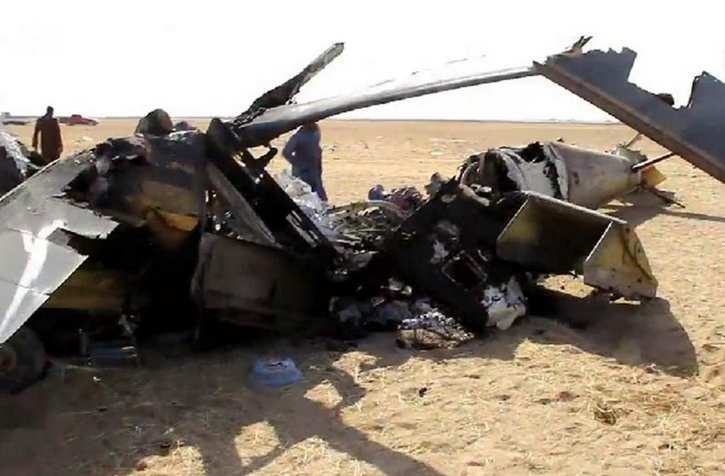
The burnt out wreckage of YI-35X
Comment
-
Apaches Engage Islamic State
http://www.upi.com/Top_News/World-Ne...1412537180/Apache helicopters were used in air assaults against the Islamic State over the weekend, the first such strikes utilizing the Army's premier attack helicopter.
In a statement on its website, CENTCOM reported a series of bombings against IS targets in Iraq's Anbar province:
"Four strikes northeast of Fallujah struck two mortar teams, a large ISIL unit and two small ISIL units. One strike southeast of Hit destroyed two ISIL humvees. One strike northeast of Sinjar destroyed an ISIL Humvee.
To conduct these strikes, the U.S. employed attack, bomber, fighter and helicopter aircraft deployed to the U.S. Central Command area of operations. All aircraft departed the strike areas safely."

US Army Apaches
A CENTCOM official told Defense News that the helicopter was a US Army Apache.
CENTCOM stands for U.S. Central Command, which oversees US military operations in the Middle East, Central Asia and portions of North Africa.
In July, the White House announced that along with an additional 300 troops, it was sending in drone aircraft and helicopters, including Apaches, to improve security around the US embassy in Baghdad.
According to Pentagon officials, there are 1,200 U.S. troops currently deployed to Iraq.
Comment
-
Bell 407 Down: Iraq
http://www.njherald.com/story/267323...-helicopterISIS rebels have shot down a Bell 407 helicopter killing both crewmen on board in the second such incident in a week and raising concerns about the extremists' ability to attack aircraft amid ongoing US-led airstrikes.
According to Iraqi officials, the extremists used a shoulder-fired missile to take down the Bell 407 helicopter, which crashed just north of the refinery town of Beiji, located about 200 kilometers (130 miles) north of Baghdad.

An Iraqi Army Aviation Bell 407 such as the one which has been shot down today
The pilot and co-pilot were both killed in the attack, a military aviation official told The Associated Press. A Defense Ministry official confirmed the information. Both officials spoke on condition of anonymity in line with regulations.
This is the second Iraqi military helicopter shot down by the Islamic State group over Beiji in one week. Militants shot down an Mi-35 helicopter near Beiji on Friday, also killing the pilot and co-pilot in that attack.
The two incidents highlight the Islamic State group's ability to counter air operations, potentially putting at risk U.S.-led airstrikes in Iraq and Syria. Some fear the militants may have captured some sophisticated weapons, such as ground-to-air missiles capable of shooting down airplanes when they overran abandoned Iraqi army bases this summer.
European airlines including Virgin Atlantic, KLM and Air France, U.S. carrier Delta Air Lines and Dubai-based Emirates changed their commercial flight plans over the summer to avoid the Iraqi airspace.
Crash site photos:
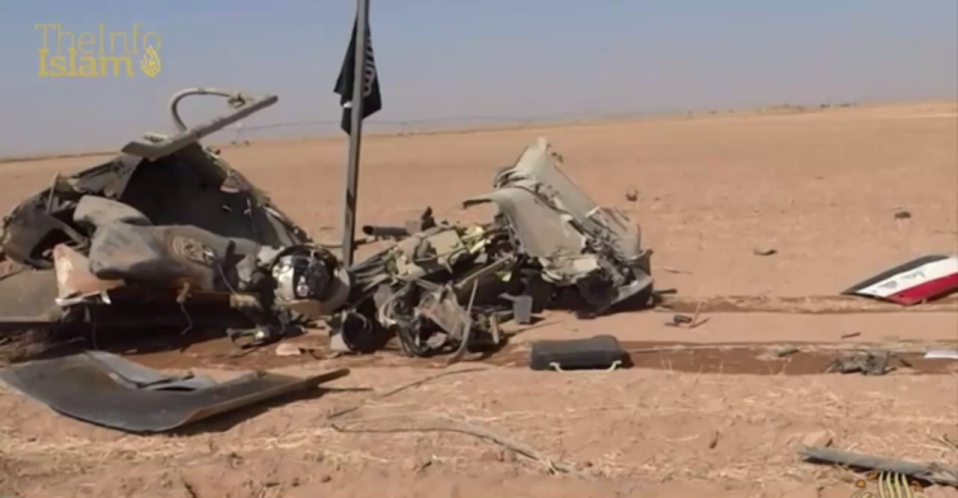
The remains of the Bell 407 which was shot down by the Islamic State (ISIS). The rebel group erected their flag in the midst of the wreckage as a proud exclamation of their 'handiwork'

The remains of the 407's rotorhead as well as the cargo door cover
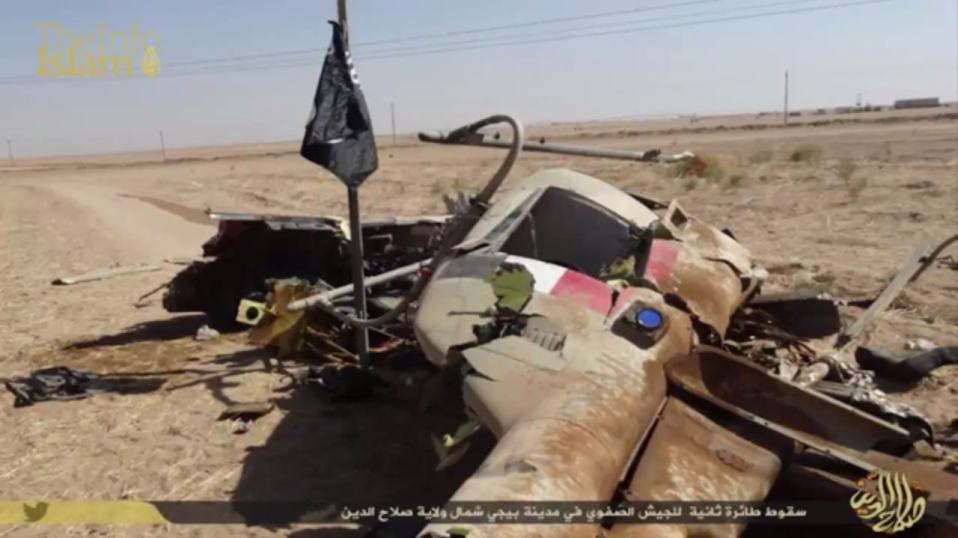
The helicopter was downed by an ISIS-captured MANPAD while flying a reconnaissance mission
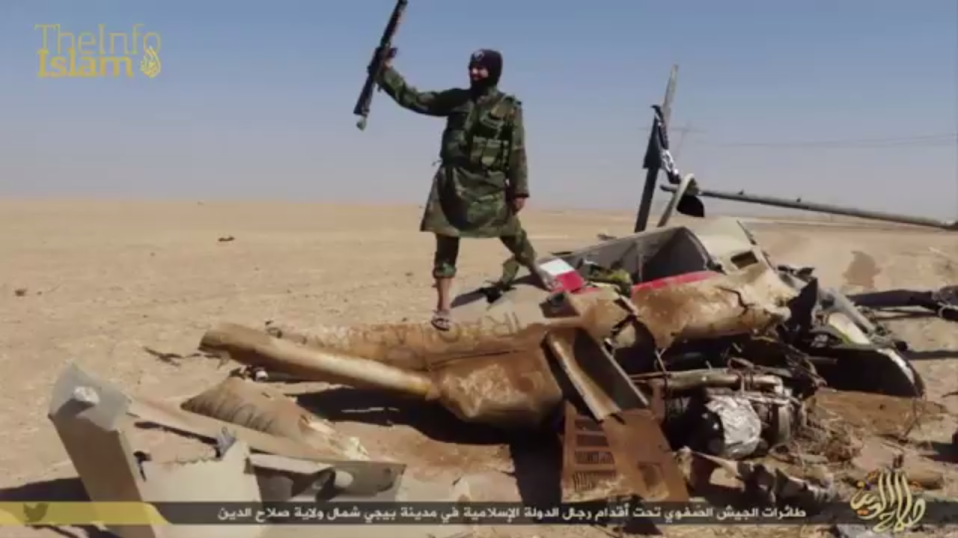
An ISIS fighter stands on top of the wreckage
Comment
-
The Growing Threat From Ground Fire in Iraq
http://www.nytimes.com/2014/10/27/wo...s.html?_r=0From the battlefield near Baiji, an Islamic State jihadist fired a heat-seeking missile and blew an Iraqi Army Mi-35M attack helicopter out of the sky this month, killing its two crew members.
Days later, the Islamic State released a chilling series of images from a video purporting to capture the attack in northern Iraq: a jihadist hiding behind a wall with a Chinese-made missile launcher balanced on his shoulder; the missile blasting from the tube, its contrail swooping upward as it tracked its target; the fiery impact and the wreckage on a rural road.
The helicopter was one of several Iraqi military helicopters that the militants claim to have shot down this year, and the strongest evidence yet that Islamic State fighters in Iraq are using advanced surface-to-air missile systems that pose a serious threat to aircraft flown by Iraq and the American-led coalition.
As the counteroffensive against the Islamic State enters a more aggressive phase in Iraq, allied airstrikes will also intensify. American officials say they fully expect that the push will bring out more proof of the jihadists’ antiaircraft abilities, with potentially serious consequences for how the Iraqis and their coalition partners wage their war.
“Based on past conflicts,” said one senior American military official who spoke on the condition of anonymity to discuss delicate intelligence assessments, the missiles “are game changers out there.”
The proliferation of antiaircraft weaponry has also heightened concerns about the vulnerability of Iraq’s airports, particularly Baghdad International Airport, the country’s most important transportation hub and a lifeline for military supplies and reinforcements to Iraq.
Signaling its intent to challenge American supremacy in the skies, the Islamic State, also known as ISIS or ISIL, recently published an online guide describing how to use shoulder-fired missiles to shoot down an Apache attack helicopter, one of the most fearsome weapons in the United States Army’s conventional arsenal.
“Choosing the launching spot: Preferably somewhere high,” the guide says in Arabic. “The roof of a building or a hill with a solid surface to prevent the appearance of dust following launching.”
The authors urged “strong confidence in God and composure,” and certainty “that this operation will cause a disaster to the foes and destroy their arrogance.”
The United States has stationed about a half-dozen Apaches at Baghdad International Airport, but they have been used only rarely in the two-and-a-half-month-old aerial campaign against the Islamic State, in part because of worries about their vulnerability to ground fire and because of a lack of American search-and-rescue teams in Iraq that could respond to downed aircrews. The concerns also reflect the White House’s insistence on limiting the number of American troops in Iraq and their exposure to hostile fire.
This month, Apaches entered the battle for the first time, in coordination with United States Air Force jets, to carry out four airstrikes on a large Islamic State force northeast of Falluja, in the sprawling desert and agricultural province of Anbar. The militants have established several strongholds there, and have continued to gain ground there against Iraq’s security forces in recent weeks.
Now, though, the Iraqi military is beginning to mount larger and more complex efforts around the country to retake territory from the Islamic State, including a counteroffensive that began a week and a half ago to break the militants’ stranglehold on a key refinery in Baiji, north of Baghdad. The new phase will mean an increase in the frequency of combat missions by coalition aircraft, and will likely demand a greater use of lower-flying American attack helicopters and gunships, which have important advantages in urban warfare.
Since much of the most difficult fighting in the coming months is expected to unfold in the towns and cities of Anbar, American generals may be inclined to order more Apaches to support Iraqi ground troops. They may also make greater use of AC-130 gunships, a lumbering, propeller-driven plane bristling with cannons that circles at altitudes at the outer limits of some shoulder-fired missiles.
As Iraqi and American officials weigh the added risk to their aircrews and, potentially, to civilian aircraft, they are particularly concerned about the threat of shoulder-fired heat-seeking missiles, commonly known as Manpads, short for Man-Portable Air Defense Systems.
Syrian rebels have amassed multiple Manpad models since 2012, and the Islamic State has generally had little trouble acquiring any weapon used by Syrian rebels either through purchase or capture, military analysts say. Though the Pentagon’s Central Command acknowledges this concern, it said it had no conclusive evidence yet that the Islamic State had such weapons.
The maximum ranges and altitudes of Manpads vary from system to system, but they are generally used against low-flying aircraft, such as fixed-wing aircraft soon after takeoff or shortly before landing, or helicopters.
Sunni militants in Iraq have long maintained a limited, aging stock of SA-7 Manpads, a ubiquitous Soviet-designed system that they periodically used during the American occupation from 2003 to 2011, said Charles Lister, a visiting fellow at the Brookings Doha Center in Qatar.
Since at least late 2013, however, the Islamic State’s forces in Iraq appear to have acquired more sophisticated antiaircraft missile systems, including the Chinese-made FN-6, originally provided by Qatar and possibly also Saudi Arabia to Syrian rebels.
In the images purporting to show the shooting down of the Iraqi attack helicopter, on Oct. 3 in Baiji, the militant, a scarf wrapped around his face, is wielding a Chinese-made FN-6 missile system — apparently the first documented use of the weapon by Islamic State jihadists in Iraq, analysts said.
The militants claimed to have shot down several other Iraqi military helicopters this year, most recently a Bell 407 on a surveillance mission near Baiji on Oct. 8.
“Judging by reports from Iraq, and in particular Anbar Province, over the last three to four months, it would seem ISIL have been using Manpads far more frequently and more successfully than Syrian rebels have ever done,” Mr. Lister added.
An even greater potential concern is that militants might get their hands on SA-24’s, a more sophisticated system that Russia recently sold to Iraq, and first showed up in militant videos in September, said Matthew Schroeder, a missile proliferation analyst at Small Arms Survey, an independent research project based in Geneva.
The SA-24’s have a longer range than older models and use faster and more maneuverable missiles, Mr. Schroeder said.
Newer systems also have a greater ability to hit targets from a wider range of angles, such as a perpendicular shot at a moving target like a plane on its approach to a runway.

Russia's latest MANPAD the 9K338 Igla-S (NATO reporting name SA-24 Grinch) which is a more sophisticated man-portable infrared homing surface-to-air missile
As Iraqi and United States officials have weighed the threats to their military aircraft, they have also taken steps to safeguard the nation’s airports. The protection of Baghdad International Airport, on the western edge of the capital, has been of special concern, especially since the early summer when the Islamic State’s advances in Anbar and on the western fringes of greater Baghdad brought it to within 15 miles of the airport.
Officials acknowledge that any disruption to the airport’s services by an insurgent attack of any type would have an outsize psychological and logistical impact.
In July, the Pentagon rushed the Apaches, plus Shadow surveillance drones and 200 American soldiers, to the airport based on a classified intelligence assessment that the sprawling complex was vulnerable to attack, American officials say.
But although the Islamic State has continued to score victories in nearby Anbar, the militants have not advanced closer to the city since the summer, easing fears that the airport was going to be overrun. Iraqi and American military officials have insisted in interviews that they have taken the necessary precautions to protect the airport and aircraft there, and that there is not an imminent danger of attack.
Vehicle access to the passenger terminal area is tightly controlled with special permission granted on a case-by-case basis. The airport is bordered on the east and northeast by a large military complex. In the farmlands that abut the rest of the complex, the government has militarized the roads with a heavy police and military presence and checkpoints, and, officials said, infiltrated the neighborhoods with intelligence officers.
“We’re very sure that Baghdad International Airport is safe for departure and for arrival,” said Capt. Saad M. Saeed, the general director of Iraqi Airways, Iraq’s national carrier. “I’m a pilot. If I know there’s one-in-a-million chance, I won’t take the risk.”
Yet in August, an Iraqi Airways captain told colleagues that his plane had been hit by gunfire as it approached the airport from the north, a route that would have passed over the restive Sunni district of Abu Ghraib. The plane, which landed safely, was hit by at least two bullets, according to two Iraqi Airways pilots who said they had been told about the shooting.
Ali al-Bayati, deputy director of Iraqi Airways, denied that such an event had occurred. Rumors, he said, were part of the Islamic State’s arsenal. “Considering that the airport is a very high-value target for them,” he said, “they’re spreading a lot of rumors.”
Comment
-
Helicopter Down: Iraq
http://www.latimes.com/world/middlee...-story.htmlAn Iraqi military helicopter has been shot down by Islamic State militants near the Sunni-dominated city of Samarra, killing the two pilots. The Sunni extremists also were reported on the verge of taking a western Iraq town from poorly equipped government forces.
Iraqi news reports said Saturday that the military helicopter had been shot down near Mutassem, a strategic entry to the Shiite Muslim holy city of Samarra about 80 miles north of the capital.
It wasn't immediately clear what type of helicopter was shot down, or exactly when. Iraq’s Alhurra television channel reported that a helicopter was shot down Saturday, as did the Associated Press, but antigovernment activists claimed that one helicopter, maybe two, were downed Friday.
Iraqi defense ministry officials in Samarra said they could not confirm details of the crash.
Central Samarra has been secured by the Iraqi army and several Shiite militias that have led the battle against Islamic State, which controls much of northern and western Iraq as well as parts of Syria.
Comment

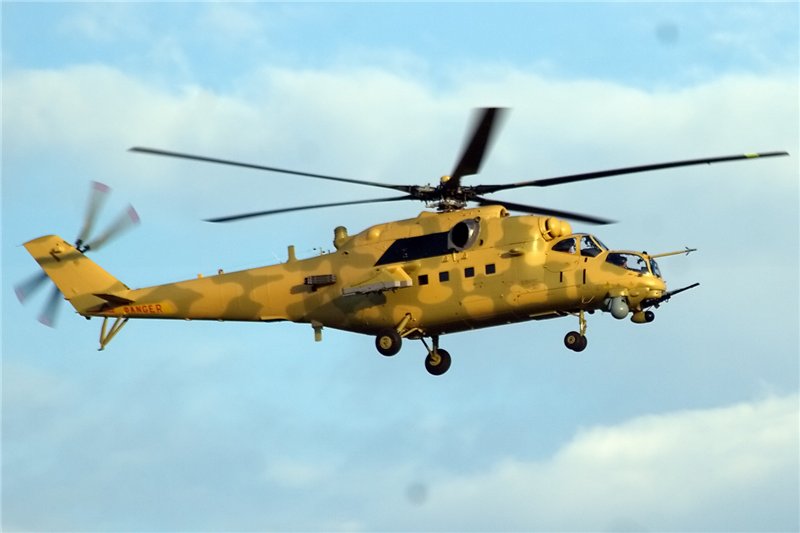

Comment